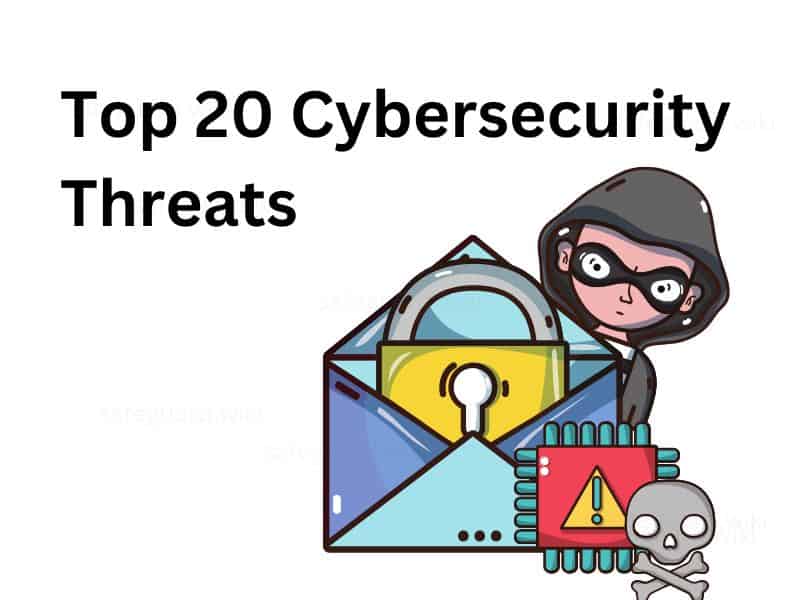The Insidious World of Cybersecurity Threats
Cybersecurity threats have, unfortunately, become a part of the online landscape, a perennial concern for website owners like us. Whether you manage an e-commerce portal, a blog, or a corporate website, the specter of cyber threats looms large. Today, let’s delve into the top twenty cybersecurity threats that we should be acutely aware of, and arm ourselves with knowledge to build a safer digital environment. In the future, we will cover each one in more detail.
1. Phishing Attacks
Phishing, my friends, is a classic and yet, devastating cyber threat. Imagine casting a line into a pond hoping to snag a fish. Cybercriminals do something similar. They send out deceptive emails that appear legitimate, with the hope that an unsuspecting victim will reveal sensitive information like login credentials or credit card details. In fact, according to the 2022 Internet Crime Report by the FBI, phishing was the most common type of cybercrime reported, and the damages were staggering. This certainly makes it a force to reckon with.
2. Ransomware
Ransomware is a scary word in the cybersecurity world. It’s akin to a digital hostage situation. Malicious software encrypts your data, and the perpetrators demand a ransom, usually in cryptocurrency, to unlock it. High-profile ransomware attacks, like the one on the Colonial Pipeline in 2021, illustrate the destructive potential of this threat. The attack led to a temporary shutdown of the largest pipeline for refined oil products in the U.S., causing a nationwide panic and illustrating just how critical and robust cybersecurity measures are.
3. Malware
Next up is malware. This umbrella term covers various harmful software such as viruses, worms, Trojans, and spyware. They infiltrate your system and cause damage, often without your knowledge. Notably, malware can be spread through several channels like email attachments, software downloads, or even malicious advertisements. A multi-layered security approach, including regularly updating your software, can help protect your website from these stealthy invaders.
4. SQL Injection
A lesser-known but potent threat is SQL injection. This type of attack specifically targets websites using SQL databases. The attacker exploits vulnerabilities in a website’s database to manipulate its code. It can lead to unauthorized access to sensitive data and, in some cases, even allow full control over the website. A strong defense against SQL injections is to regularly check for and patch vulnerabilities in your website’s code.
5. Cross-Site Scripting (XSS)
Cross-site scripting, often abbreviated as XSS, is another website-specific threat to be aware of. In this attack, malicious scripts are embedded in trusted websites, which are then run by unsuspecting users’ browsers. These scripts can steal user data, like cookies, allowing the attacker to impersonate the user and gain unauthorized access. A common defense against XSS attacks is to sanitize user inputs to ensure no executable code can be inserted.
6. Distributed Denial-of-Service (DDoS)
One of the most disruptive forms of cybersecurity threats is a Distributed Denial-of-Service (DDoS) attack. It involves overwhelming a website’s server with traffic, rendering it unable to handle legitimate requests and effectively knocking it offline. To mitigate the risk of a DDoS attack, consider investing in services that can detect and neutralize such threats before they cause significant harm.
7. Man-in-the-Middle (MitM) Attacks
In a Man-in-the-Middle attack, the perpetrator secretly intercepts and potentially alters the communication between two parties. This could involve eavesdropping on sensitive information or injecting malicious data. Implementing strong encryption protocols and HTTPS for your website is a potent countermeasure against MitM attacks.
8. Password Attacks
The simplicity of password attacks shouldn’t lull you into a false sense of security. Brute force attacks, dictionary attacks, keyloggers, or phishing can all be used to crack or steal passwords, giving attackers easy access to your systems. Emphasizing strong, unique passwords, two-factor authentication, and secure password management practices can be instrumental in defending against such attacks.
9. Advanced Persistent Threats (APTs)
Advanced Persistent Threats (APTs) are long-term targeted attacks where cybercriminals infiltrate a network to steal data over an extended period. APTs usually target organizations with high-value information, such as financial institutions or governments. However, no one is truly immune. Maintaining up-to-date security protocols, regular audits, and continuous monitoring can help detect and mitigate these stealthy threats.
10. Insider Threats
Last but not least, we need to consider insider threats. Not all cybersecurity threats originate from faceless hackers on the internet. Sometimes, they come from within your own organization. This could be a disgruntled employee, a careless mistake, or even a well-intentioned teammate unknowingly creating vulnerabilities. Regular training, strict access controls, and monitoring can go a long way in preventing insider threats.
In this perilous digital landscape, understanding these cybersecurity threats is the first step in protecting your online presence. By staying informed, vigilant, and proactive, we can safeguard our websites and ensure a secure online environment for our users.

11. Social Engineering
Social engineering is a sinister craft where hackers exploit human psychology to gain unauthorized access. It could be in the form of a seemingly harmless email from a “friend” or a phone call from a “bank representative.” Education and awareness are key in recognizing and preventing such attacks.
12. Botnets
A botnet is a network of infected devices, controlled by hackers, used to perform coordinated attacks. This could mean a DDoS attack, sending spam, or spreading malware. Regular system checks and robust security protocols can help safeguard your systems from being ensnared in a botnet.
13. Cryptojacking
Cryptojacking is the unauthorized use of someone else’s computer to mine cryptocurrency. This sneaky threat not only slows down your systems but also can cause significant financial damage. Implementing a network monitoring solution and keeping all software up-to-date are practical ways to prevent cryptojacking.
14. Drive-By Downloads
Drive-by downloads occur when a user unintentionally downloads malicious software onto their device simply by visiting an infected website. Installing a reliable security solution, ensuring regular system updates, and safe browsing practices can minimize this risk.
15. Eavesdropping Attacks
During eavesdropping attacks, also known as sniffing or snooping attacks, hackers intercept company data while it’s being transmitted. These can be mitigated by enforcing strong encryption methods for data transmission and regularly updating network security tools.
16. AI-Powered Attacks
With the rise of artificial intelligence, we are also seeing AI-powered cyber attacks. These can range from using machine learning algorithms for cracking passwords to AI-driven malware that can adapt to evade detection. Keeping abreast of the latest cybersecurity trends and technologies is crucial in defending against these advanced threats.
17. IoT-Based Attacks
Internet of Things (IoT) devices, like smart home gadgets or wearables, have become a favorite target for cybercriminals due to their often lax security features. Ensure any IoT devices connected to your network have strong security measures, including unique, robust passwords, and timely updates.
18. Zero-Day Exploits
Zero-day exploits take advantage of security vulnerabilities on the same day that the weakness becomes generally known. There is often no time to patch the problem before damage can be done. Regularly updating and patching your systems can help protect against these attacks.
19. Cloud Vulnerabilities
As more businesses move their data to the cloud, vulnerabilities in cloud security have become a growing concern. Ensuring strong cloud security measures like encryption, intrusion detection systems, and secure access credentials can mitigate these threats.
20. Deepfake Technology
Finally, deep fake technology, which uses AI to create hyper-realistic but fake audio and video content, poses a new cybersecurity threat. Deepfakes can be used in phishing attacks or to spread disinformation. Awareness and education about deep fakes, as well as employing AI-based detection tools, can aid in countering this threat.
Knowledge is our best defense against these cybersecurity threats. With a proper understanding of what we’re up against, we can take steps to protect our systems and our data.
© 2016-2023 by LiVentures. All rights reserved. No part of this document may be reproduced or transmitted in any form or by any means, electronic, mechanical, photocopying, recording, or otherwise, without prior written permission of LiVentures.



